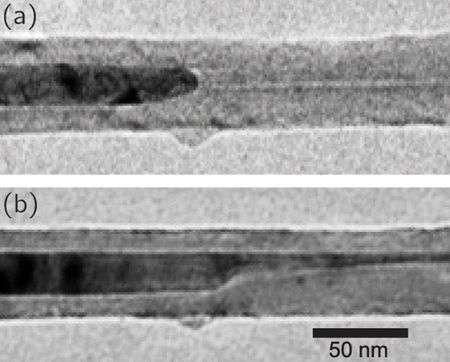May 2, 2013 report
Researchers discover nanocrystals able to squeeze through nanotubes without changing

(Phys.org) —Researchers at the University of California, Berkeley, have discovered that a nanocrystal moving through a nanotube due to an electric charge is able to pass through a portion of the nanotube that is smaller in diameter than the crystal, without melting or undergoing compression. In their paper published in the journal Physical Review Letters, the team describes how they observed an iron nanocrystal move through a narrow channel in a nanotube without its properties being changed in the process.
Scientists have known for some time that if metal crystals are inserted into a nanotube, then the crystals will move through the tube if an electric current is applied. The speed and direction of the crystals can be controlled by modifying the amount and direction of the current. However, that was always done with uniform width nanotubes. In this new effort, the researchers created a nanotube that had a diameter of 20 nm for most of its length—in its middle section however, they caused the nanotube to constrict to a diameter of just 5 nm.
The assumption was that when an electric charge was applied to an iron nanocrystal introduced into the nanotube, it would be stopped-up by the constriction until either the crystal melted due to the heat of the current applied, or was squished as it was forced through the smaller space. Instead, the researchers found, by watching through an electron microscope, that the crystal was able to move through the constriction before either occurred, without undergoing any changes at all. Instead, it simply rearranged itself. They noted also that the crystal moved through the constriction at the same speed, regardless of its length, so long as the current remained stable.
The researchers aren't sure exactly how the crystal was able to move through the constriction, but theorize that atoms on the back side of the crystal structure somehow migrated, or diffused to the front—over and over again until the crystal had, in essence, re-formed itself on the other side of the blockage. The discovery of this phenomenon could lead to new ways to synthesize metal crystals or to increase their purity.
More information: Surface Atom Motion to Move Iron Nanocrystals through Constrictions in Carbon Nanotubes under the Action of an Electric Current, Phys. Rev. Lett. 110, 185901 (2013) prl.aps.org/abstract/PRL/v110/i18/e185901
Abstract
Under the application of electrical currents, metal nanocrystals inside carbon nanotubes can be bodily transported. We examine experimentally and theoretically how an iron nanocrystal can pass through a constriction in the carbon nanotube with a smaller cross-sectional area than the nanocrystal itself. Remarkably, through in situ transmission electron imaging and diffraction, we find that, while passing through a constriction, the nanocrystal remains largely solid and crystalline and the carbon nanotube is unaffected. We account for this behavior by a pattern of iron atom motion and rearrangement on the surface of the nanocrystal. The nanocrystal motion can be described with a model whose parameters are nearly independent of the nanocrystal length, area, temperature, and electromigration force magnitude. We predict that metal nanocrystals can move through complex geometries and constrictions, with implications for both nanomechanics and tunable synthesis of metal nanoparticles.
Journal information: Physical Review Letters
© 2013 Phys.org



















